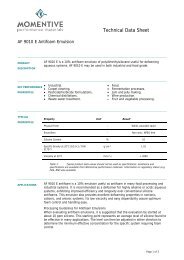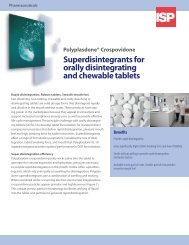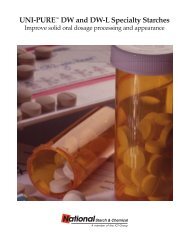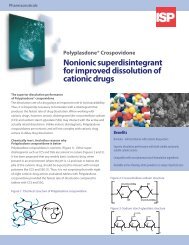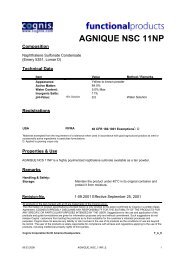Inert Lubricants Oils – Greases – Waxes - Anshul Life Sciences
Inert Lubricants Oils – Greases – Waxes - Anshul Life Sciences
Inert Lubricants Oils – Greases – Waxes - Anshul Life Sciences
Create successful ePaper yourself
Turn your PDF publications into a flip-book with our unique Google optimized e-Paper software.
Solubility of Gases in Halocarbon Fluids<br />
Halocarbon fluids dissolve gases readily. Chlorine, for example, is soluble to the extent of<br />
several weight percent at ambient conditions. Oxygen, nitrogen and carbon dioxide dissolve<br />
to the extent of 0.15, 0.26 and 1.3 mL of gas per mL of Halocarbon 27 oil at 25°C (77°F) and<br />
atmospheric pressure, respectively. Gas solubility increases with an increase in pressure.<br />
Halocarbon 27 oil dissolves 10.2 mL of nitrogen gas per mL of oil at 1,000 psig (7.0 MPa)<br />
and 37.8°C (100°F) but Halocarbon 6.3 oil dissolves only 5.4 mL of gas per mL of oil under<br />
the same conditions.<br />
Oil viscosity and density are reduced appreciably by dissolved gas.<br />
Bulk Modulus<br />
Bulk modulus measurements for Halocarbon oils are well over 200,000 psi (1,379 MPa)<br />
at 37.8°C (100°F) with applied pressures up to 10,000 psig (69.1 MPa). Halocarbon<br />
oils have compressibilities similar to mineral oils and are much less compressible than<br />
perfluoropolyethers.<br />
Lubricity<br />
Halocarbon oils can be used interchangeably with hydrocarbon oils to lubricate a wide range<br />
of equipment such as bearings, compressors, gear boxes and oil pumps. Occasionally, some<br />
equipment modification may be required because of density, viscosity or vapor pressure<br />
differences from hydrocarbon lubricants.<br />
Extreme-pressure tests using the four-ball method show that Halocarbon oils and greases<br />
are very good lubricants. The oils exhibit no seizure even at a final applied load of 800 Kg.<br />
These greases and oils have load wear indexes that are appreciably better that hydrocarbon<br />
oils. Scar diameters increasing uniformly with increasing applied load.<br />
Halocarbon oils have been used successfully in all types of equipment for over 50 years.<br />
However, if there is any question of suitability or interchangeability, a monitored test in the<br />
equipment is advised.<br />
Thermal Properties<br />
Heats of vaporization of Halocarbon oils vary from 36 to 54 BTU/lb (84 to 126 KJ/Kg). Their<br />
specific heats range from 0.2 to 0.25 BTU/(lb)(°F) [837 to 1,047 J/(Kg)(°C)] as the molecular<br />
weight increases. Thermal conductivities also increase with molecular weight, but they are<br />
all close to 0.1 BTU/(hr)(ft2)(°F/ft) [0.17 W/(°K)(m)].<br />
back to Contents<br />
11



